Jesteś nowym użytkownikiem WordPressa lub w końcu jesteś gotowy na przejście z klasycznego edytora na edytor blokowy?
Edytor blokowy WordPress jest domyślnym edytorem do pisania treści i edycji twojej witryny internetowej. Został wprowadzony w 2019 roku z przydomkiem Gutenberg i zastąpił stary klasyczny edytor.
W WPBeginner wcześnie przeszliśmy z klasycznego edytora na Gutenberg. Nasi autorzy używają edytora blokowego od lat, a po drodze nauczyliśmy się kilku cennych wskazówek i sztuczek.
Po wielu latach zabawy z edytorem bloków, mamy głębokie zrozumienie, jak efektywnie z niego korzystać.
W tym poradniku pokażemy ci, jak korzystać z edytora bloków WordPress i opanować go, aby tworzyć wizualnie oszałamiające wpisy i strony na blogu.
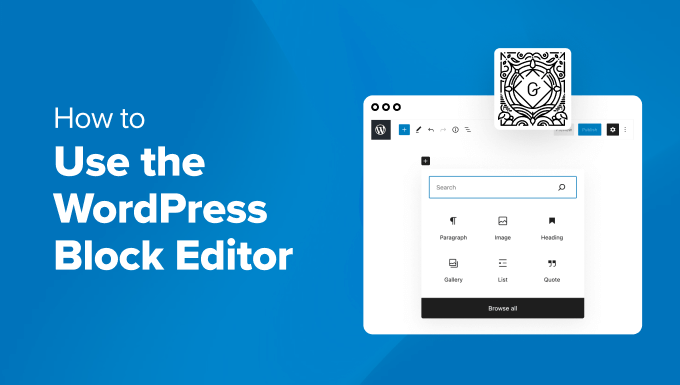
Uwaga: W tym artykule mówimy o korzystaniu z edytora bloków, który jest przeznaczony do edycji twoich wpisów i stron. Jeśli zastanawiasz się, jak edytować całą twoją witrynę internetową za pomocą bloków, zapoznaj się z naszym kompletnym przewodnikiem po pełnej edycji witryny WordPress.
Jaka jest różnica między edytorem bloków (Gutenberg) a edytorem klasycznym?
Zanim zagłębimy się w edytor bloków, porównajmy i zrozumiejmy różnice między edytorem bloków Gutenberg a starszym edytorem klasycznym.
Oto jak wyglądał klasyczny edytor w WordPress:
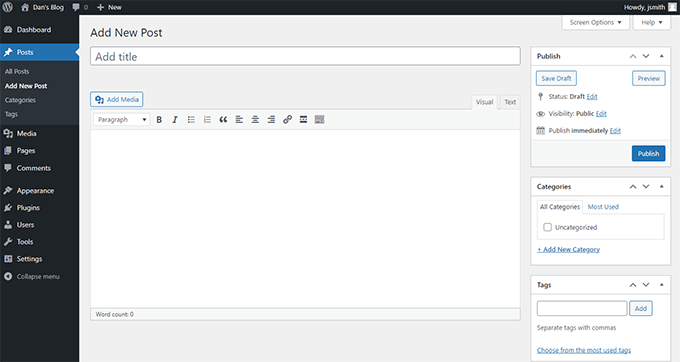
Posiadał on okno edytora tekstu z kilkoma podstawowymi opcjami formatowania. Jego funkcjonalność i wygląd były dość ograniczone.
Tak wygląda edytor bloków w WordPress:
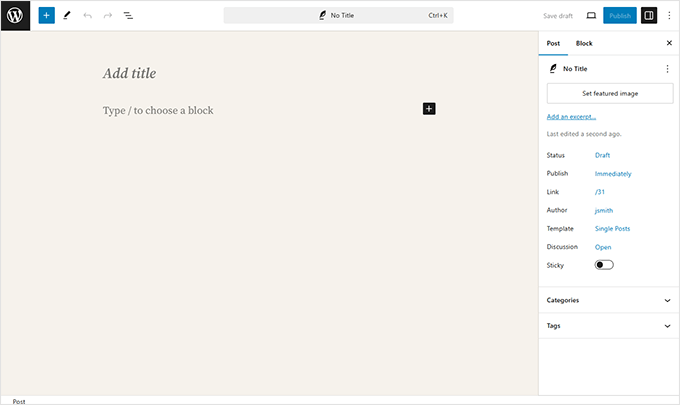
Jak widać, są to dwa zupełnie różne edytory do tworzenia treści w WordPressie.
Stary klasyczny edytor był edytorem tekstu z przyciskami formatowania podobnymi do Microsoft Word.
Nowy edytor wykorzystuje inne podejście zwane “blokami” (stąd nazwa Block Editor).
Bloki to elementy treści, które można dodawać do ekranu edycji w celu tworzenia układów. Każdy element dodany do twojego wpisu lub strony jest blokiem.
Na przykład, można dodawać bloki dla akapitów, obrazków, filmów, galerii, audio, list i innych. Istnieją bloki dla wszystkich popularnych elementów treści, a więcej można dodać za pomocą wtyczek WordPress.
W czym edytor bloków WordPress jest lepszy od klasycznego edytora?
Edytor bloków WordPress oferuje prosty sposób dodawania różnego rodzaju treści do twoich wpisów i stron.
Na przykład, jeśli wcześniej chciałeś dodać tabelę do twojej treści za pomocą klasycznego edytora, potrzebowałeś osobnej wtyczki tabeli.
Dzięki edytorowi bloków możesz po prostu dodać blok tabeli, wybrać kolumny i wiersze, a następnie rozpocząć dodawanie treści.
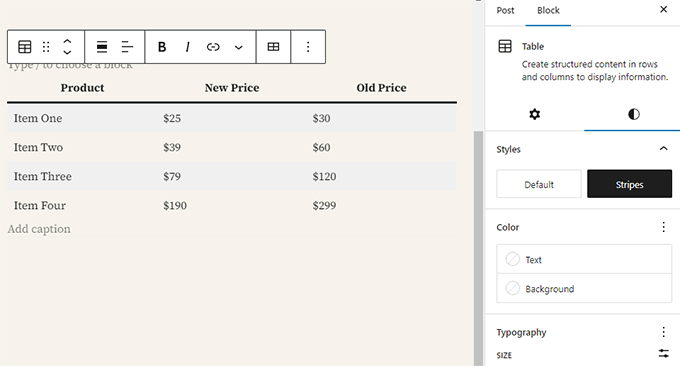
Możesz przenosić elementy treści w górę i w dół, edytować je jako pojedyncze bloki i łatwo tworzyć treści bogate w multimedia.
Co najważniejsze, edytor bloków WordPress jest łatwy w użyciu i nauce.
Daje to ogromną przewagę wszystkim początkującym użytkownikom WordPressa, którzy właśnie rozpoczynają swój pierwszy blog lub budują witrynę internetową dla majsterkowiczów.
To powiedziawszy, przyjrzyjmy się, jak korzystać z edytora bloków WordPress, aby tworzyć świetne treści jak profesjonalista.
Oto, co omówimy w tym poradniku Gutenberg:
- Using Gutenberg – The WordPress Block Editor
- Creating a New Blog Post or Page Using The Block Editor
- How to Add a Block in the Block Editor
- Working With Blocks in the New Editor
- Organizing Blocks in Groups and Columns
- Saving and Reusing Blocks in Gutenberg
- Publishing and Managing Options in Gutenberg Block Editor
- Plugin Settings in Gutenberg
- Adding Some Common Blocks in the Block Editor
- Exploring Other Content Blocks in the Block Editor
- Bonus Tips to Use Gutenberg Like a Pro
- Adding More Blocks to Gutenberg Block Editor in WordPress
- FAQs About Gutenberg – The Block Editor in WordPress
- Video Tutorial
- Bonus Resources
Gotowy? Zanurzmy się.
Korzystanie z Gutenberg – edytora bloków WordPress
Edytor bloków został zaprojektowany tak, aby był intuicyjny i elastyczny. Chociaż wygląda inaczej niż stary edytor WordPress, nadal robi wszystkie rzeczy, które można było zrobić w klasycznym edytorze.
Zacznijmy od omówienia podstawowych rzeczy, które robiłeś w klasycznym edytorze i jak są one wykonywane w edytorze bloków.
Tworzenie nowego wpisu na blogu lub strony przy użyciu edytora bloków
Rozpoczniesz tworzenie nowego wpisu na blogu lub strony w normalny sposób. Wystarczy kliknąć na menu Posty ” Dodaj nowy wpis w twoim WordPress administratorze.
Jeśli tworzysz stronę, przejdź do menu Strony ” Utwórz nową.
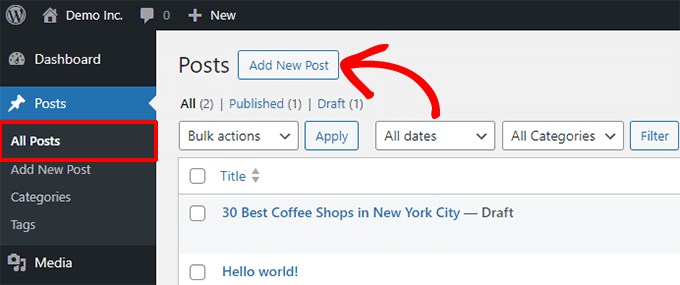
Spowoduje to uruchomienie edytora bloków.
Jak dodać blok w edytorze bloków
Pierwszym blokiem każdego wpisu lub strony jest tytuł.
Możesz użyć myszy, aby przejść poniżej tytułu lub nacisnąć klawisz Tab na twojej klawiaturze, aby przesunąć kursor w dół i rozpocząć pisanie.
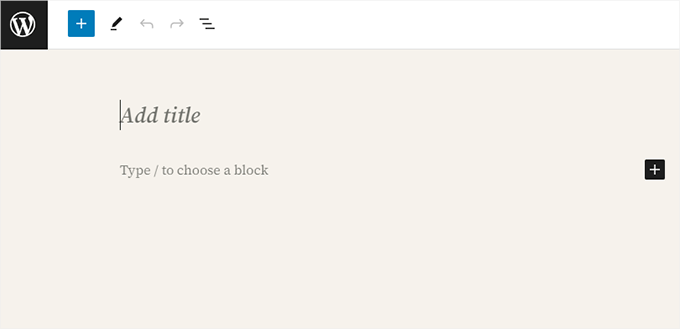
Domyślnie następnym blokiem jest blok akapitu. Pozwala to użytkownikom na natychmiastowe rozpoczęcie pisania.
Jeśli jednak chcesz dodać coś innego, możesz kliknąć przycisk Utwórz nowy blok [+] w lewym górnym rogu edytora, pod istniejącym blokiem lub po prawej stronie bloku.
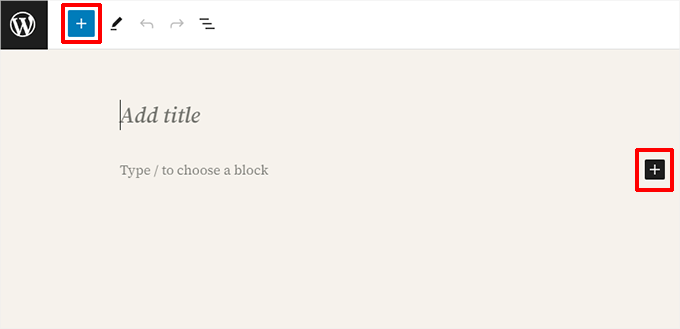
Kliknięcie przycisku spowoduje wyświetlenie menu dodawania bloków z paskiem wyszukiwania u góry i najczęściej używanymi blokami poniżej.
Możesz klikać karty, aby przeglądać kategorie bloków lub wpisać rodzaj słowa kluczowego, aby szybko wyszukać określony blok.
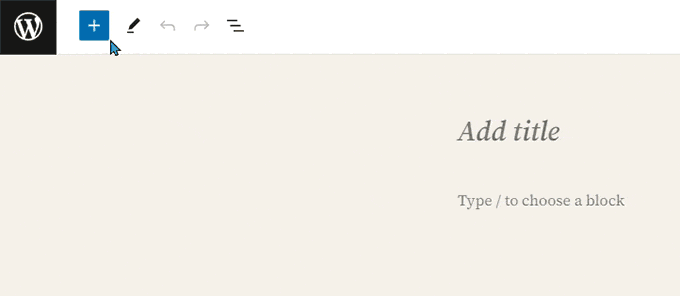
Jeśli nie chcesz używać myszy do kliknięcia przycisku, możesz również użyć skrótu klawiaturowego.
Zacznij od wpisania rodzaju /, aby wyszukać blok, a następnie wstaw go, naciskając klawisz Enter na twojej klawiaturze.
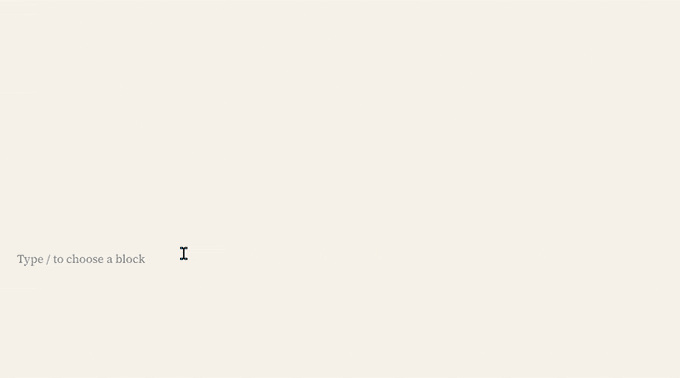
Praca z blokami w nowym edytorze
Każdy blok ma pasek narzędzi, który pojawia się na górze. Przyciski na pasku narzędzi zmieniają się w zależności od edytowanego bloku.
Na przykład, na poniższym zrzucie ekranu pracujemy nad blokiem Akapit, który pokazuje podstawowe przyciski formatowania, takie jak wyrównanie tekstu, pogrubienie, kursywa, wstawienie odnośnika i inne opcje, które są dostępne w menu z trzema kropkami.
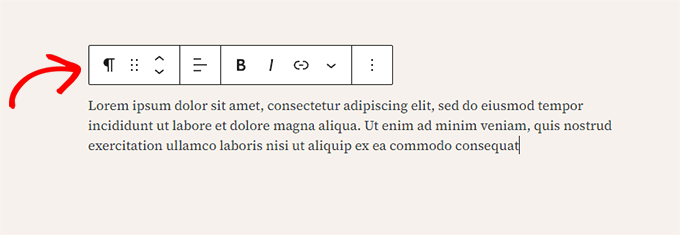
Oprócz paska narzędzi, każdy blok może mieć własne ustawienia bloku, które pojawiają się w prawej kolumnie ekranu edycji.
Ustawienia te różnią się w zależności od edytowanego bloku. Na przykład blok Akapit umożliwia edycję koloru tekstu, tła i odnośnika, a także typografii.
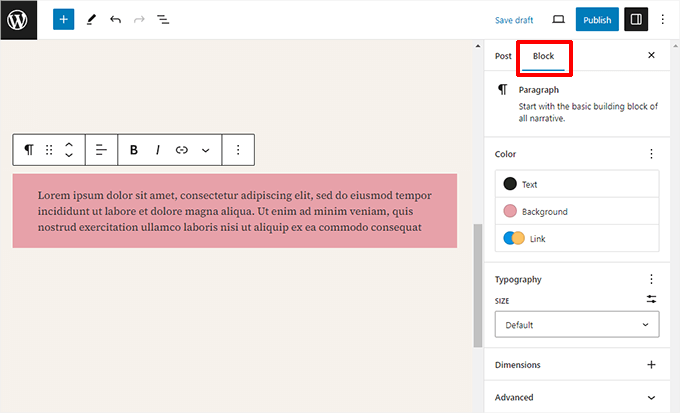
Możesz przesuwać bloki w górę i w dół oraz zmieniać ich układ.
Jeśli chcesz to zrobić, po prostu kliknij, aby przeciągnąć lub upuścić lub kliknij przyciski w górę i w dół na pasku narzędzi bloku.
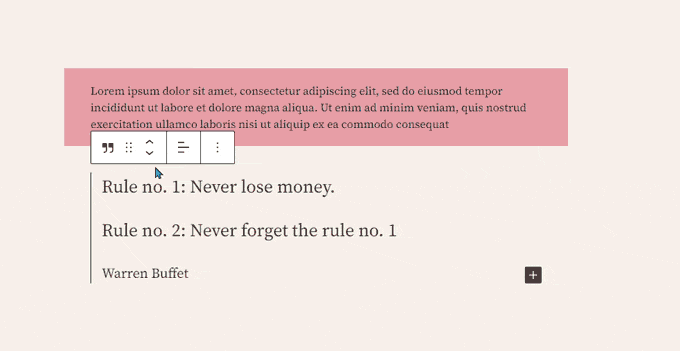
Powiązane: Zobacz nasz przewodnik, jak usuwać blok w WordPress.
Organizowanie bloków w grupach i kolumnach
Edytor bloków zawiera również przydatne narzędzia do zarządzania i organizowania twoich układów treści.
Możesz zaznaczyć wiele bloków, klikając je z wciśniętym klawiszem Shift na twojej klawiaturze.
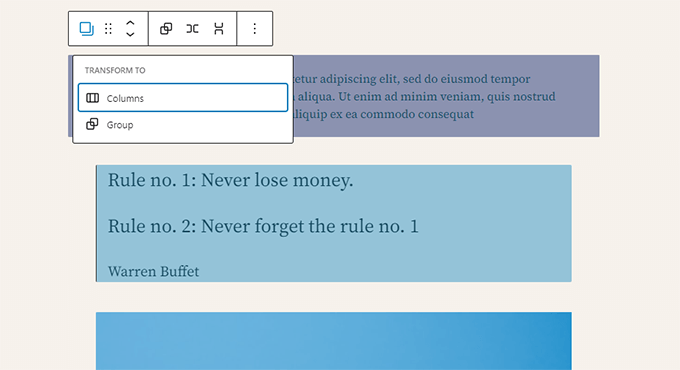
Następnie kliknij przycisk rodzaju bloku na pasku narzędzi, aby przekształcić wybrane bloki w Grupy lub Kolumny.
Następnie można zastosować style do całego bloku grupy, np. zmieniając wyrównanie lub odstępy.
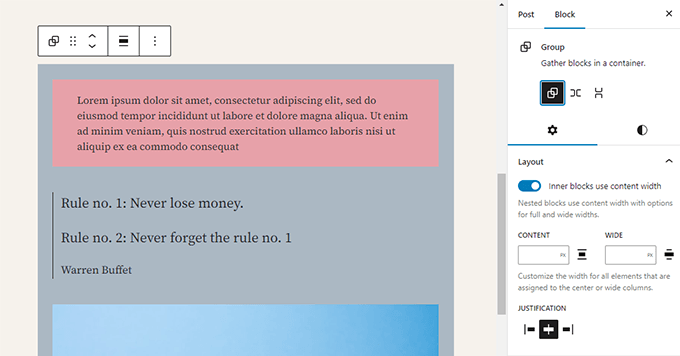
Edytor bloków umożliwia także dodanie pustego bloku Grupy lub Kolumny.
Następnie możesz wypełnić je innymi blokami.
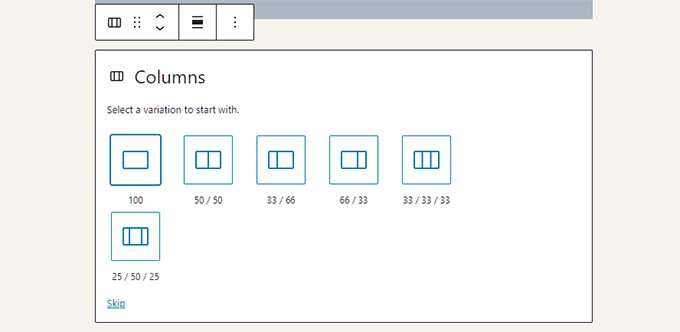
W każdej kolumnie można dodać dowolny rodzaj bloku.
Pozwala to na tworzenie 111111 pięknych układów dla różnych przypadków użycia.
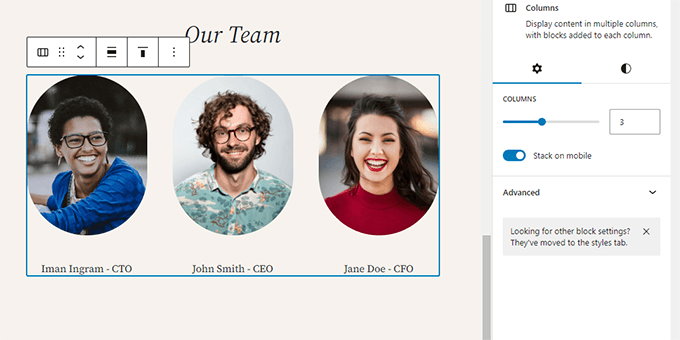
Zapisywanie i ponowne wykorzystywanie bloków w Gutenbergu
Jedną z najlepszych rzeczy w korzystaniu z bloków jest to, że można je zapisywać i ponownie wykorzystywać. Jest to szczególnie przydatne dla właścicieli witryn internetowych i blogerów, którzy często muszą dodawać określone fragmenty kodu do swoich artykułów lub stron.
Wystarczy kliknąć przycisk menu w prawym rogu paska narzędzi każdego bloku. Z menu wybierz opcję “Utwórz wzorzec”.
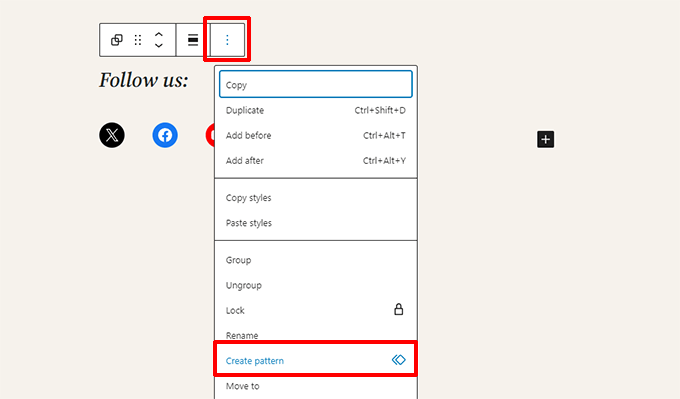
Uwaga💡: Można również używać całych grup i kolumn jako bloków wielokrotnego użycia. Pozwala to na zapisywanie całych sekcji i używanie ich w razie potrzeby.
Spowoduje to otwarcie okna, w którym należy podać nazwę tego wzorca. Może to być cokolwiek, co pomoże ci łatwo zidentyfikować, kiedy musisz go ponownie użyć.
Następnie można opcjonalnie wybrać kategorie. Pomaga to posortować twoje wzorce w zorganizowany sposób.
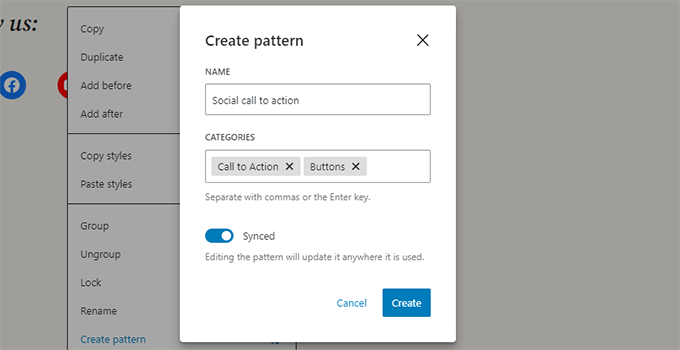
Następnie kliknij przycisk “Utwórz”, aby zapisać twój wzorzec. WordPress zapisze twój wzorzec ze wszystkimi znajdującymi się w nim blokami.
Aby ponownie użyć twojego wzorca, po prostu edytuj wpis lub stronę, na której chcesz go dodać.
Następnie kliknij przycisk dodawania bloku [+] lub użyj skrótu klawiaturowego /. Możesz znaleźć wzorzec, wpisując rodzaj nadanej mu nazwy.
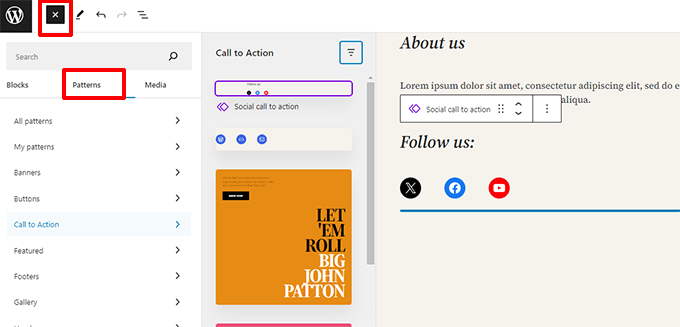
Wzorce ułatwiają właścicielom witryn dodawanie powszechnie używanych elementów do ich układów, takich jak wezwania do działania, przyciski mediów społecznościowych, banery i inne.
Twój motyw WordPress lub wtyczki mogą nawet zawierać własne wzorce lub możesz znaleźć wzorce stworzone przez innych w bibliotece WordPress Block Patterns.
Jeśli potrzebujesz więcej pomocy, przygotowaliśmy osobny przewodnik dla początkujących na temat znajdowania i używania wzorców bloków WordPress.
Publikowanie i zarządzanie opcjami w edytorze bloków Gutenberg
Każdy wpis WordPress zawiera wiele metadanych. Obejmuje to informacje takie jak data publikacji, kategorie i tagi, wyróżniające się obrazki i wiele innych.
Wszystkie te opcje są starannie umieszczone w prawej kolumnie na ekranie edytora.
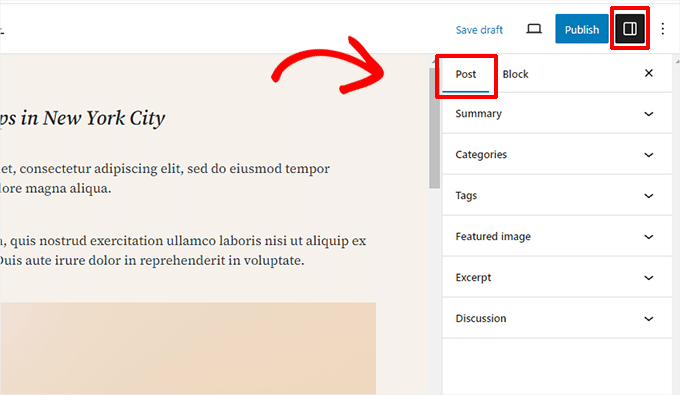
Opcje wtyczek w Gutenbergu
Wtyczki WordPress mogą korzystać z API edytora bloków, aby zintegrować swoje ustawienia na ekranie edycji.
Niektóre popularne wtyczki posiadają własne bloki.
Na przykład WPForms, najlepsza wtyczka do formularzy kontaktowych WordPress, umożliwia dodawanie formularzy do twojej treści za pomocą bloku.
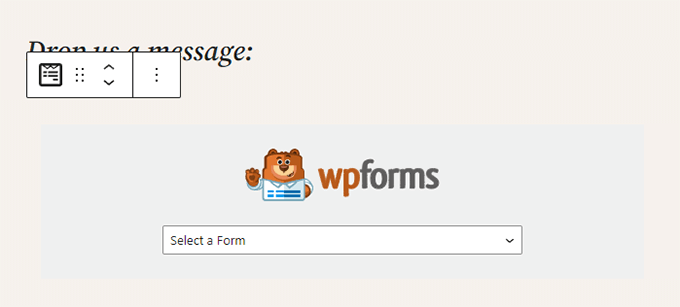
Inne wtyczki WordPress mogą również dodawać swoje ustawienia do ekranu edytora bloków.
Na przykład, oto jak All in One SEO dla WordPress pozwala edytować twoje ustawienia SEO w dolnej części edytora bloków:
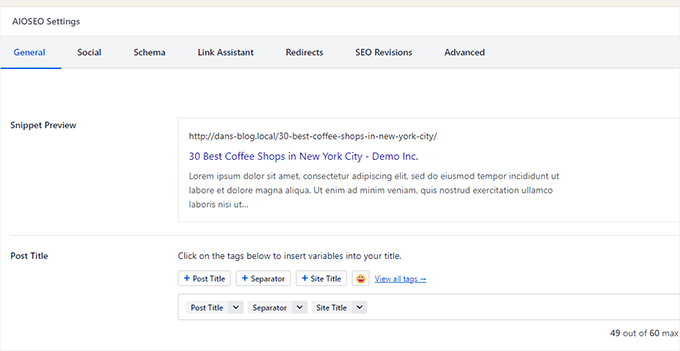
Podobnie, jeśli prowadzisz sklep internetowy za pomocą WooCommerce, to powiadomienie, że ma on również swoje własne bloki.
Bloki te umożliwiają dodawanie twoich produktów do dowolnych wpisów i stron WordPress.
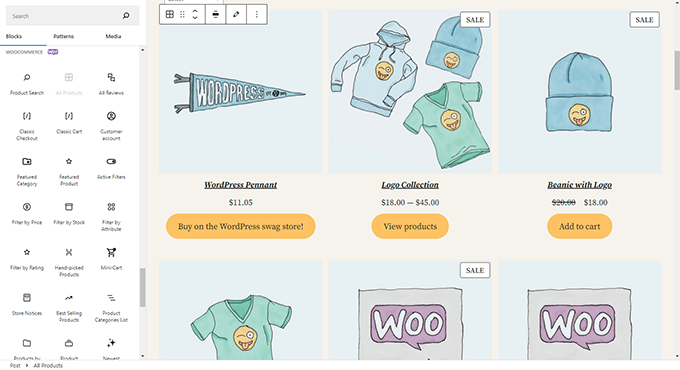
Dodawanie niektórych popularnych bloków w edytorze bloków
Edytor bloków może robić wszystko to, co starszy edytor klasyczny.
Będziesz jednak robić rzeczy szybciej i bardziej elegancko niż wcześniej. Ponadto może zrobić znacznie więcej, na przykład pozwolić ci stylizować twoją treść za pomocą wielu opcji bez kodu.
Oto niektóre z popularnych bloków, których można użyć.
1. Dodawanie obrazka w edytorze bloków WordPress
W edytorze bloków WordPress znajduje się gotowy do użycia blok Obrazek. Wystarczy dodać blok, a następnie przesłać plik z obrazkiem lub wybrać go z biblioteki multimediów.
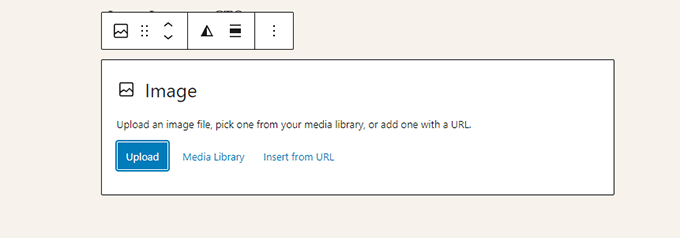
Możesz także przeciągać i upuszczać obrazki z twojego komputera, a edytor automatycznie utworzy blok Image.
Po dodaniu obrazka wyświetlone zostaną ustawienia bloku, w których można dodać metadane dla obrazka, takie jak tekst alternatywny, rozmiar rozdzielczości obrazka i dodanie odnośnika do obrazka.
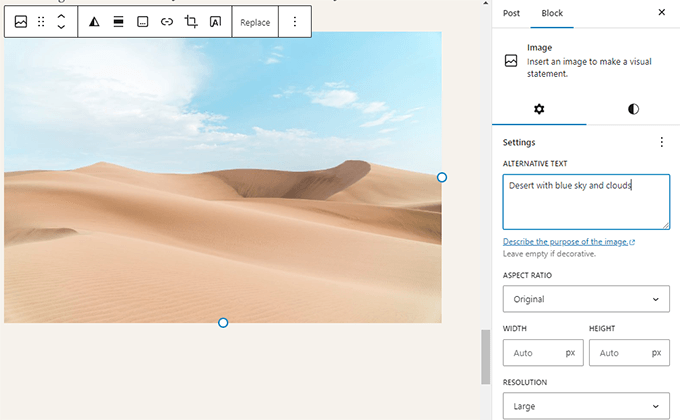
Aby uzyskać więcej informacji, wystarczy zapoznać się z naszym poradnikiem na temat dodawania obrazków w WordPressie.
2. Dodawanie odnośnika w edytorze bloków
Edytor bloków zawiera kilka bloków, w których można dodawać tekst. Najczęściej używanym jest blok Akapit, który posiada przycisk wstaw odnośnik na pasku narzędzi.
Wszystkie inne często używane bloki tekstowe również posiadają przycisk odnośnika na pasku narzędzi.

Można również wstawić odnośnik za pomocą skrótu klawiaturowego, którym jest Command + K na komputerach Mac i CTRL + K na komputerach z systemem Windows.
3. Dodawanie galerii obrazków w Gutenbergu
Blok Galeria działa podobnie jak blok obrazków. Dodajesz go, a następnie przesyłasz lub wybierasz pliki obrazków.
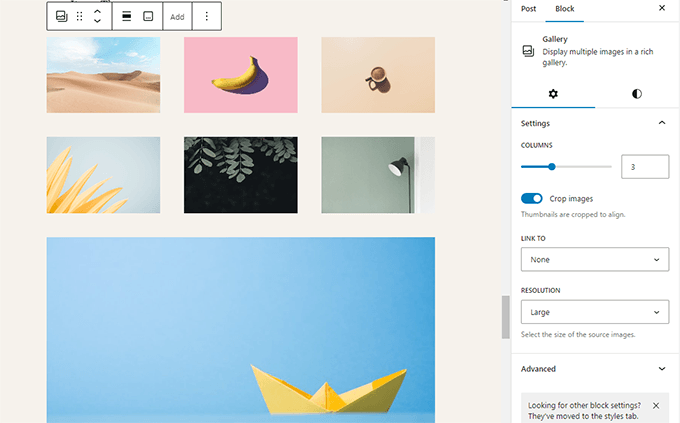
Więcej szczegółów można znaleźć w naszym przewodniku na temat tworzenia galerii obrazków w WordPress.
4. Dodawanie krótkich kodów we wpisach WordPress przy użyciu Gutenberga
Wszystkie twoje krótkie kody będą działać tak samo, jak w klasycznym edytorze. Możesz po prostu dodać je do bloku Paragraph lub użyć bloku Shortcode.
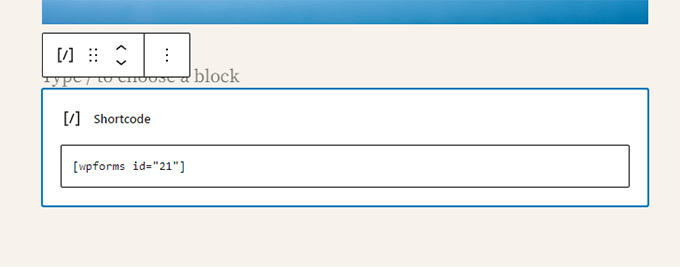
Eksplorowanie innych bloków treści w edytorze bloków
Edytor Gutenberg obiecał rozwiązać pewne długotrwałe problemy z użytecznością w WordPressie poprzez wprowadzenie nowych bloków.
Poniżej znajdują się niektóre z ulubionych, które naszym zdaniem będą niezwykle pomocne dla użytkowników.
1. Dodawanie obrazka obok tekstu w WordPressie
Wielu naszych użytkowników nie mogło umieścić obrazka obok tekstu za pomocą starego edytora. Teraz można to zrobić za pomocą bloku Media i tekst.
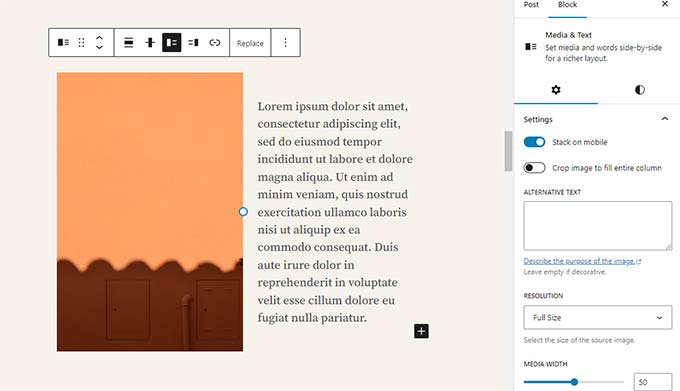
Ten prosty blok składa się z dwóch bloków umieszczonych obok siebie, umożliwiając łatwe dodanie obrazka z tekstem obok niego.
2. Dodawanie przycisku we wpisach i na stronach WordPressa
Kolejną uciążliwością starego edytora było dodawanie przycisków do twoich wpisów lub stron na blogu. Trzeba było albo użyć wtyczki, która tworzyła krótki kod dla przycisku, albo przełączyć się do trybu HTML i napisać kod.
Na szczęście Gutenberg ma blok Button, który pozwala szybko dodać przycisk do dowolnego wpisu lub strony.
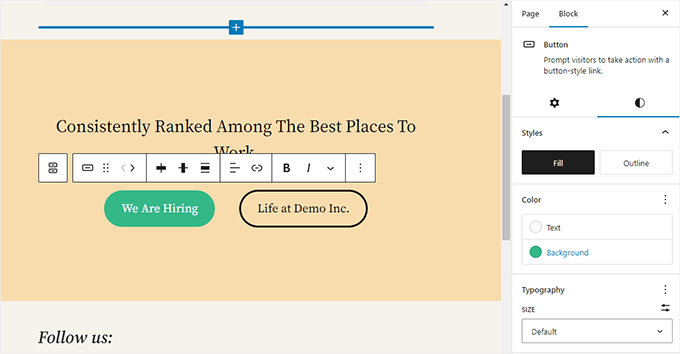
Możesz dodać odnośnik do twojego przycisku, zmienić kolory i wiele więcej. Aby uzyskać szczegółowe informacje, zobacz nasz artykuł na temat łatwego dodawania przycisków w WordPress.
3. Dodawanie pięknych obrazków w wpisach na blogu i na stronach docelowych
Inną fajną funkcją, którą warto wypróbować, jest blok okładek, który umożliwia dodawanie obrazków okładek lub kolorowych okładek tła do twoich wpisów i stron.
Obrazek okładki to szerszy obrazek często używany do nowej sekcji na stronie lub początku relacji. Wygląda 111111 pięknie i pozwala tworzyć angażujące układy treści.
Wystarczy dodać blok Okładka, a następnie przesłać obrazek, którego chcesz użyć. Możesz wybrać kolor nakładki dla okładki lub ustawić ją jako poprawiony obrazek tła, aby stworzyć efekt paralaksy, gdy użytkownicy przewijają stronę w dół.
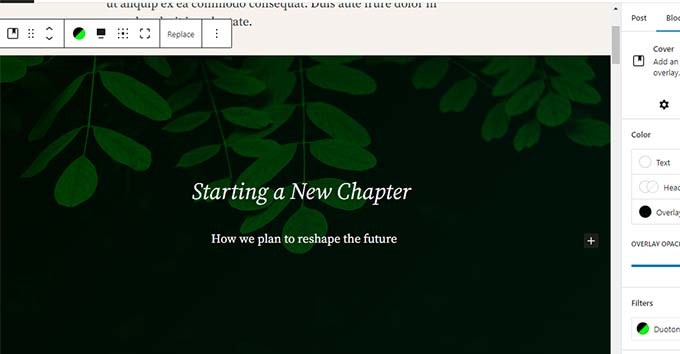
Więcej szczegółów można znaleźć w naszym artykule na temat różnicy między okładką a obrazkami wyróżniającymi w WordPress.
4. Tworzenie tabel wewnątrz artykułów
Klasyczny edytor nie miał przycisku do dodawania tabel do twoich wpisów WordPress. Trzeba było użyć wtyczki lub utworzyć tabelę, pisząc własny CSS i HTML.
Teraz edytor bloków ma domyślny blok Tabela, dzięki czemu dodawanie tabel do twoich wpisów i stron jest bardzo łatwe. Wystarczy dodać blok i wybrać liczbę kolumn i wierszy, które chcesz wstawić.

Możesz teraz rozpocząć dodawanie danych do wierszy tabeli. W razie potrzeby zawsze możesz dodać więcej wierszy i kolumn, a dostępne są dwie podstawowe opcje stylu.
5. Tworzenie treści wielokolumnowych
Tworzenie treści wielokolumnowych było kolejnym problemem, z którym klasyczny edytor w ogóle sobie nie radził.
Na szczęście edytor bloków umożliwia dodanie bloku Kolumny, który dodaje dwie kolumny bloku akapitu.
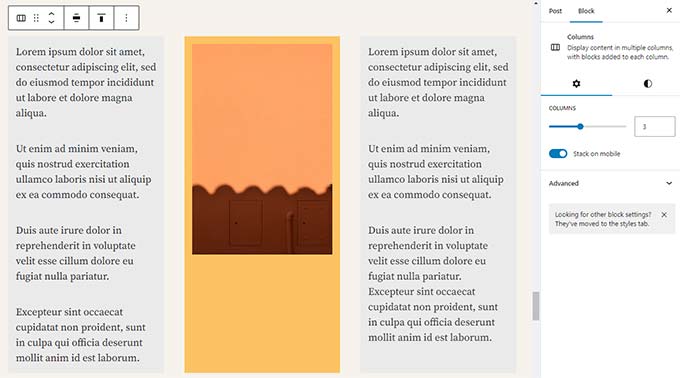
Ten blok kolumn jest dość elastyczny. Można dodać do 6 kolumn w rzędzie, a nawet użyć innych bloków wewnątrz każdej kolumny.
Dodatkowe wskazówki dotyczące korzystania z Gutenberga jak profesjonalista
Patrząc na edytor bloków, można się zastanawiać, czy nie spędzimy więcej czasu na dodawaniu i dostosowywaniu bloków niż na tworzeniu treści.
Cóż, edytor bloków jest niesamowicie szybki, a nawet bardzo podstawowe użycie przez kilka minut pozwoli ci dodawać bloki natychmiast, nawet bez zastanowienia.
Wkrótce zdasz sobie sprawę, o ile szybszy stanie się twój przepływ pracy dzięki takiemu podejściu.
Oto kilka dodatkowych wskazówek dla zaawansowanych użytkowników, które pomogą ci jeszcze szybciej pracować z edytorem bloków WordPress.
1. Przesuń pasek narzędzi bloku na górę
Być może zauważyłeś na powyższych zrzutach ekranu, że pasek narzędzi pojawia się na górze każdego bloku. Możesz przenieść ten pasek narzędzi na górę edytora.
Aby uzyskać dostęp do opcji “Górny pasek narzędzi”, kliknij przycisk z trzema kropkami w prawym górnym rogu ekranu.
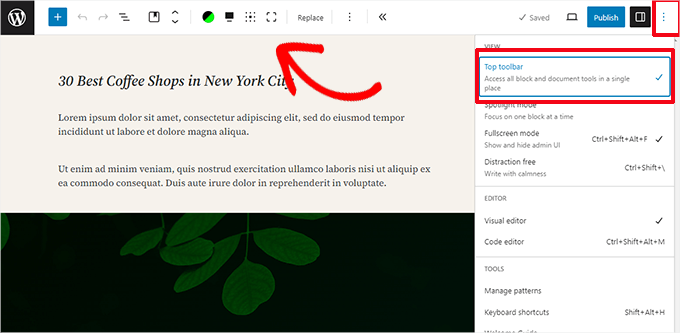
2. Używanie skrótów klawiaturowych
Gutenberg zawiera kilka przydatnych skrótów, które sprawią, że twój przepływ pracy będzie jeszcze szybszy i łatwiejszy. Pierwszym z nich, którego powinieneś zacząć używać od razu, jest /.
Po prostu wpisz /, zacznij pisać, a edytor wyświetli pasujące bloki, które możesz natychmiast dodać.
Aby uzyskać więcej skrótów, kliknij menu z trzema kropkami w prawym górnym rogu twojego ekranu i wybierz “Skróty klawiaturowe”.
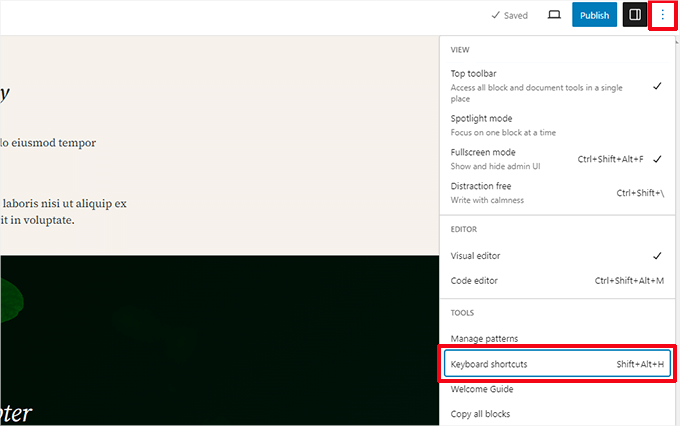
Spowoduje to wyświetlenie wyskakującego okienka z listą wszystkich skrótów klawiaturowych, których można użyć. Lista będzie zawierać różne skróty dla użytkowników systemów Windows i Mac.
3. Przeciągnij i upuść multimedia, aby automatycznie utworzyć bloki multimedialne
Gutenberg umożliwia przeciąganie i upuszczanie plików w dowolnym miejscu na ekranie, automatycznie tworząc blok dla użytkownika.
Można na przykład upuścić pojedynczy obrazek lub plik z filmem, a blok zostanie utworzony. Alternatywnie, możesz upuścić wiele plików obrazków, aby utworzyć blok galerii.
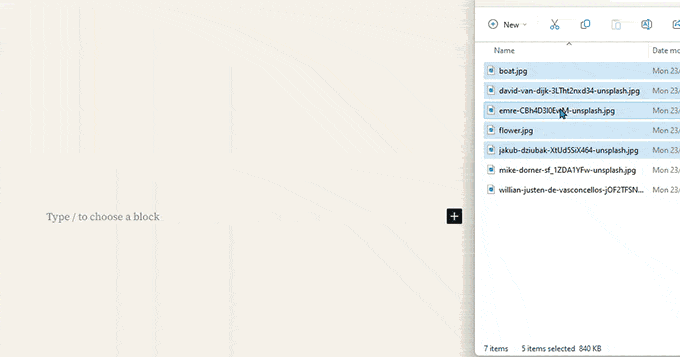
4. Osadzanie treści z YouTube, Twittera, Vimeo i innych serwisów
Edytor bloków ułatwia osadzanie treści innych firm w twojej treści WordPress. Dostępne są bloki dla wszystkich popularnych usług innych firm.
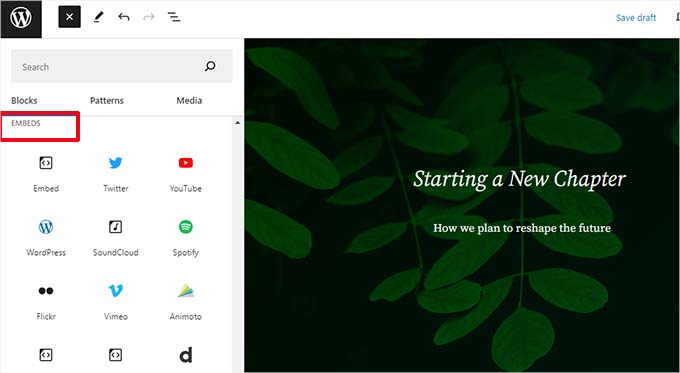
Możesz jednak po prostu skopiować i wkleić adres URL osadzania w dowolnym momencie, a blok zostanie automatycznie utworzony.
Na przykład dodanie adresu URL filmu z YouTube spowoduje automatyczne utworzenie bloku osadzania YouTube i wyświetlenie filmu.
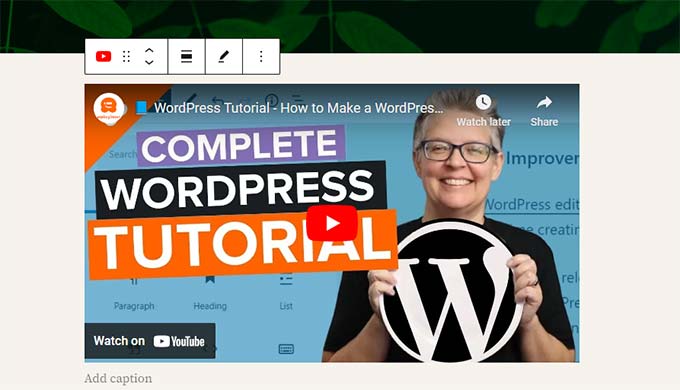
Domyślna opcja osadzania nie będzie działać w przypadku osadzania postów na Facebooku i Instagramie, ale istnieje obejście. Zobacz nasz artykuł na temat osadzania wpisów z Facebooka i Instagrama w WordPress.
Dodawanie kolejnych bloków do edytora bloków Gutenberg w WordPress
Edytor bloków w WordPress umożliwia programistom tworzenie własnych bloków. Niektóre doskonałe wtyczki WordPress oferują pakiety bloków dla nowego edytora.
Oto kilka z nich:
1. Spectra WordPress Gutenberg Blocks

Spectra WordPress Gutenberg Blocks to biblioteka bloków z wieloma zaawansowanymi blokami, które pomagają dodać więcej elementów projektu do twojej treści.
Spectra, stworzona przez ludzi stojących za popularnym motywem Astra WordPress, pomaga tworzyć 111111 piękne projekty bez pisania jakiegokolwiek kodu.
Aby uzyskać więcej informacji, zobacz naszą pełną recenzję Spectra.
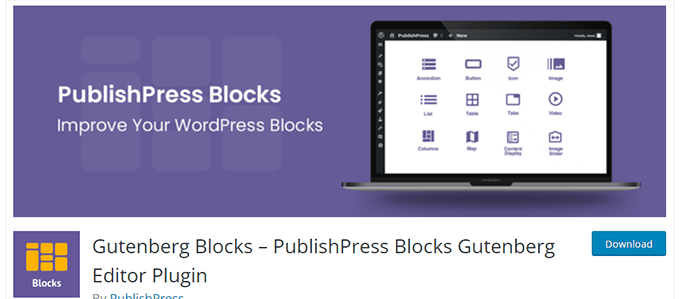
PublishPress Blocks to kolejna potężna biblioteka bloków, która zawiera dodatkowe bloki rozszerzające edytor bloków Gutenberg.
Zawiera piękne opcje układu, pokaz slajdów, przyciski, ikonki, galerie obrazków, mapy, karty, referencje, akordeony i wiele więcej.
3. Możliwość układania w stosy – bloki Gutenberg
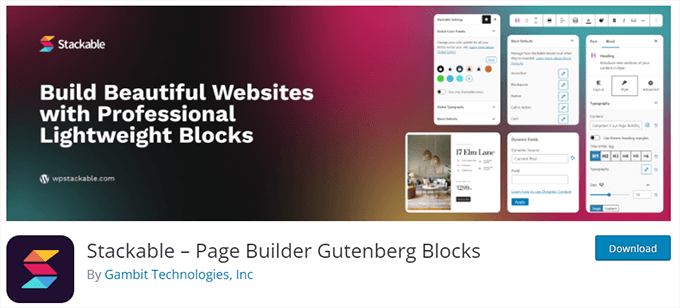
Stackable – Gutenberg Blocks to kolekcja 111111 pięknie zaprojektowanych bloków Gutenberg, które możesz wykorzystać na swojej witrynie internetowej. Zawiera bloki dla kontenera, wpisów, siatki funkcji, akordeonu, ramki z obrazkami, listy ikonek, wezwania do działania i innych.
Aby uzyskać więcej opcji, zobacz naszą pełną listę najlepszych wtyczek blokowych WordPress Gutenberg.
Najczęściej zadawane pytania dotyczące Gutenberga – edytora bloków w WordPressie
Odkąd Gutenberg stał się domyślnym edytorem WordPress, otrzymujemy wiele pytań o to, jak z niego korzystać. Oto odpowiedzi na niektóre z najczęściej zadawanych pytań dotyczących edytora bloków.
1. Co się stanie z moimi starszymi wpisami i stronami w edytorze bloków? Czy nadal mogę je edytować?
Edytor bloków nie ma wpływu na twoje stare wpisy i strony. Nadal możesz je edytować, a edytor bloków automatycznie otworzy je w bloku zawierającym klasyczny edytor.
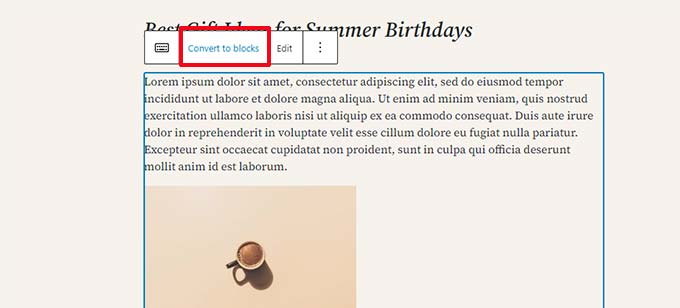
Można je edytować w starym edytorze lub przekonwertować starsze artykuły na bloki i korzystać z edytora bloków.
2. Czy mogę nadal używać starego edytora?
Tak, nadal możesz korzystać ze starego edytora. Wystarczy zainstalować i włączać wtyczkę Classic Editor.
Po włączaniu edytor bloków zostanie wyłączony i będzie można nadal korzystać z klasycznego edytora.
Należy pamiętać, że edytor klasyczny będzie wspierany do 2025 roku. Aby zapoznać się z edytorem bloków, zacznij korzystać z niego już teraz.
3. Co zrobić, jeśli edytor bloków nie działa z używaną przeze mnie wtyczką lub motywem?
Projekt Gutenberg był długo w fazie rozwoju, co dało autorom wtyczek i motywów mnóstwo czasu na przetestowanie swojego kodu pod kątem zgodności [może być też “kompatybilny”].
Nadal istnieje jednak szansa, że niektóre wtyczki i motywy nie będą dobrze współpracować z edytorem bloków. W takim przypadku można zainstalować wtyczkę Classic Editor, poprosić dewelopera o dodanie pomocy technicznej Gutenberg lub znaleźć alternatywną wtyczkę lub motyw.
4. Jak mogę dowiedzieć się więcej o poradach i sztuczkach Gutenberga?
WPBeginner to najlepsze miejsce, aby dowiedzieć się więcej o edytorze bloków w WordPress. Jesteśmy największą witryną z zasobami WordPress w Internecie.
Będziemy publikować nowe artykuły i aktualizować nasze stare zasoby, aby pomóc ci opanować edytor bloków.
W międzyczasie, jeśli masz jakiekolwiek pytania, skontaktuj się z nami, zostawiając komentarz lub korzystając z formularza kontaktowego na naszej witrynie internetowej.
5. Problemy z Gutenbergiem?
Jeśli masz problemy z edytorem bloków WordPress, stworzyliśmy krótki przewodnik po rozwiązywaniu problemów, w którym wymieniliśmy wszystkie typowe problemy z edytorem bloków napotykane przez użytkowników i sposoby ich poprawki.
Film instruktażowy
Jeśli nie preferujesz pisemnych instrukcji, obejrzyj nasz film instruktażowy:
Zasoby bonusowe
Poniżej znajduje się kilka dodatkowych zasób, które pomogą ci efektywniej korzystać z edytora bloków:
- Edytor bloków WordPress a kreatory stron: Jaka jest różnica?
- Jak utworzyć własny blok WordPress (prosty sposób)
- Jak importować / eksportować twoje bloki WordPress Gutenberg (2 kroki)
- Widżety WordPress a bloki – jaka jest różnica? (Wyjaśnienie)
- Kompletny przewodnik dla początkujących po pełnej edycji witryny WordPress
- Najlepsze motywy blokowe do pełnej edycji witryny w WordPress
- Wskazówki dotyczące opanowania edytora treści WordPress
If you liked this article, then please subscribe to our YouTube Channel for WordPress video tutorials. You can also find us on Twitter and Facebook.





jeff
I inserted a hyperlink on a phrase and I want to change the font color for that phrase. how do I do that? please help
WPBeginner Support
If only for that specific phrase, you would need to edit the text as HMTL to add styling to that phrase at the moment
Admin
Anne
Hello!
I created a column block with 3 columns. Added content and everything was distributed across the page width equally. Then I added a 4th column and now the column block no longer distributes across the entire page width. It’s seems like it has “squooshed” (sorry, can’t think of a better word right now), all 4 columns and shrunk the info as well. I tried various alignments for each individual column and it still would not spread the entire block back out. Hope this makes sense and hope you can help. Thanks!!
WPBeginner Support
It sounds like what you added to your largest column has a minimum width that is not allowing the content to adjust which would be the root of your problem.
Admin
Mark Watts
I’m struggling with the Gutenberg block editor. Heres a couple of questions but there will surely be many more to come.
How do I add a pdf document so it opens when I click a link? Used to create and highlight the link text then select “add media” and all worked fine.
When I try to add a link from within the paragraph block I no longer see a list of possible pages and posts so that I can chose. How do I get this list.
WPBeginner Support
You would manually need to take the link from the document in your media library unless you wanted to embed it. In the paragraph block, there is the link button which is third from the right, as you type into it the dropdown should appear
Admin
Tuan
This upgrade so stupid. I spent more time to write. Haiz
WPBeginner Support
Learning a new interface can certainly be troublesome but as the interface improves it should slowly become better to use
Admin
Jennifer
I’ve searched and can’t find an applicable answer to my issue, so I’m hoping you can help me.
I upgraded to the new block system for our website this past week. I need to find and copy the url for one of our buttons (it’s a redirect to PayPal), but I can’t find the url anywhere.
There’s no “edit button” when I hover over the button in the block. I checked the html and couldn’t find it there, either – the only thing I could see were the image files for the button itself.
Clicking on the button live still redirects correctly, so I know the link is working – I just can’t find it.
Any advice?
Thanks!
Jennifer
WPBeginner Support
When you select the block there should be the block settings on the right-hand side where you would find the link settings for where the button links to if it was transferred as an image. If it is a button block then there should be the url beneath the button where you can edit it.
Admin
Franklyn Fosu
Please help me resolve the “Update failed” issue when trying to publish my articles using the Gutenberg.
WPBeginner Support
To start, you would want to go through the steps in our troubleshooting guide: https://www.wpbeginner.com/beginners-guide/beginners-guide-to-troubleshooting-wordpress-errors-step-by-step/
For a temporary workaround, you could also enable the classic editor plugin and reach out to the support for Gutenberg.
Admin
Carlos Goncalves
How to use the new advanced Css option. I Tried to put some code there, but It´s not run.
WPBeginner Support
That is for adding a class to the object, you would want to take a look at our explanation of CSS to understand classes better: https://www.wpbeginner.com/glossary/css/
Admin
Candi Clark
On the top right of my block edit page, it doesn’t say publish. The button says update. When I click that button it says page has updated but when I go take a look at it on my website it hasn’t changed. Did something not upgrade correctly to have that button not say publish?
WPBeginner Support
You may want to check any caching that you have on your site that could be causing the problem.
Admin
Jim Kielbaso
How do I go back to the old version? There was nothing wrong with it, and this version does not add anything. In fact, it makes it MUCH more confusing. It is NOT user-friendly, and it has been very frustrating. Upgrades should only be made to improve something, not just for the sake of changing.
WPBeginner Support
The new editor was created to help those new to WordPress have less of a barrier to entry. For those who prefer the old editor, there is the Classic Editor plugin and we explain that plugin in our article here: https://www.wpbeginner.com/plugins/how-to-disable-gutenberg-and-keep-the-classic-editor-in-wordpress/
Admin
Sufyan Shaikh
Good article.
WPBeginner Support
Thank you
Admin
AlannaMH
How do I change the font of text in blocks?
WPBeginner Support
For setting up your site’s font, you would want to take a look at our article here: https://www.wpbeginner.com/wp-themes/how-to-add-custom-fonts-in-wordpress/
Admin
Viktor
Time consuming, if you go to WP you will see very negative comments
For me the solution was to activate a plugin called “Disable Gutenberg”
I understand there´s a learning curve…but I pass..sorry
WPBeginner Support
If you’re not ready to use the Gutenberg editor then using a plugin like that is certainly understandable.
Admin
Frank Kinghorn
I am a complete novice in website writing and decided to use WP because it seemed to have good support. At that time I did not realise WPbeginner existed but wow! now that I’ve found various guides from wpbeginner I am convinced that I made the right choice. Specifically, this guide on the new editor is fantastic. Even its existence helped me out of a deep hole: I have installed WP on my pc so I can play with it before starting my first real website but got stumped because when I got to the stage of trying to edit a page there was no sign of the editor shown in the “Getting Started with WordPress” guide by iThemes. I spent hours trying to see if my download to my pc was corrupted or if I was missing something simple – now I know the classic editor has been replaced! Sorry for the long post but a real thank you for this guide and the several other documents I have found from WPbeginner.
WPBeginner Support
Thank you, glad our site and articles could help you get up and running with WordPress
Admin
vivek
everytime i try to publish ..all i get is Auto Draft.
cant understand what is going on
WPBeginner Support
For a starting point, you may want to go through our troubleshooting article here: https://www.wpbeginner.com/beginners-guide/beginners-guide-to-troubleshooting-wordpress-errors-step-by-step/
Admin
Aaron P
Thanks for a great article! This really helped me make the transition. I was hesitant to switch, but now that I’ve played around for a while I like the new block editor.
WPBeginner Support
You’re welcome, glad our article could ease the transition
Admin
Matthew Pan
Hi, thanks for this, was really helpful.
May I ask, for adding a button block, I’m currently unable to add one such that it opens up in a new tab. There used to be an easy checkbox for this. Do you know how to do so?
2. Adding a button in WordPress posts and pages
Thanks!
WPBeginner Support
When adding a link you should have an option with three dots that you can click to have the open in new tab option again.
There is a button block you can use to add a button to your posts and pages
Admin
sally
How do I use Grammarly app with this new editor, because I cannot see Grammarly popping down there to correct my mistakes or even show me my mistakes? Thank you.
WPBeginner Support
Once you reach the second line in a paragraph block the Grammarly check should appear in the bottom corner. If it’s not appearing you could reach out to Grammarly’s support and they should be able to help ensure it appears correctly in your editor.
Admin
Linn
Hi, as a brandnew beginner, I took two courses on WordPress 5 by Morten on Lynd. Gutenberg is easy to use. However, I still don’t know how to build header and footer with Gutenberg. I need a full width color background, onto which I add several buttons such as “about,” “services,” “products,” etc. Can you help?
WPBeginner Support
Headers and footers styling is normally handled from your theme, you would either need knowledge of HTML, CSS, and PHP or you could take a look at our article here: https://www.wpbeginner.com/wp-themes/how-to-easily-create-a-custom-wordpress-theme/
Admin
Ima
Do you know if they have been able to fix the scrolling issue in the block editor? It is really annoying that you can’t scroll to the bottom of the block section without having to go to the Settings section and scroll there. I have googled and googled some more, and I am not finding a solution. Thanks so much!
WPBeginner Support
Unless I hear otherwise, the error shouldn’t be an issue but you could reach out to the WordPress.org support for if the specific error you are running into was resolved.
Admin
Steve Briese
Come on, folks. These are not the people who created WordPress. These are the people who are kind enough to help you adjust to the blocks. How many times do they need to tell you to install the Classic Editor plugin if you don’t like blocks? I don’t know if I like blocks or not, but I feel more confident in testing them after reading this introduction. Thank You!
WPBeginner Support
Glad our article could help
Admin
Sandeep
Hi, after I installed WordPress 5.1 , using Gutenberg if go to write text, on top of first word one line will come . I am not getting what’s issue. Can tell how to solve this
WPBeginner Support
Have you tried disabling all of your plugins to see if this could be a plugin specific issue?
Admin
Denny Gibson
I’ve found no way to wrap text around images. Am I missing something or is this not as popular as I thought?
WPBeginner Support
You would want to use the Media&Text block to have your text wrap with the block editor
Admin
Tom Schulte
Is there a way to still code in html in the block editor?
I ask this because the block editor inserted an extra wide space between 2 lines which I did not want. I could and did use the classic editor’s text option to get rid of the extra space.
WPBeginner Support
Yes, you can use the ellipses in the top right to swap to HTML or you could use a classic block if you only wanted to edit a specific section in HTML
Admin
Rick Swift
I grudgingly started using this new block mentality, and I wasn’t happy about it. I am glad I found your article, though, because it has made navigating this new concept much easier.
Wondering if anyone has had this experience though. While adding tags to my Document, I will add the tags, hit enter and the little box doesn’t expand at all. I have NO idea how to see my tags that I have entered.
I use WooThemes – Canvas
Very frustrating experience right now.
WPBeginner Support
If you have not already, you may want to try disabling your plugins and/or swapping themes to see if it is a conflict with one of those that is preventing the auto-expanding tag section from displaying properly.
Admin
Charles
Maybe one day I will figure out how to use this, but at the moment it seems impossible. I have used over a dozen word processors, and various web editors, but that experience is not helping me now.
I would like to indent a number of paragraphs. Sounds simple, but I have not found a way to do it. What is the use of having a paragraph block that can’t indent?
Last time I gave up on putting in a table and went back to editing HTML in the old system.
WPBeginner Support
While the paragraph block does not have an indent option at the moment, should you use the block editor again you could add an indent using the Classic block
Admin
Craig Wallace
So the concept of allocating a Template to a new page is gone?
As far as I can see, when you are making a new page ‘from blocks’ there is not way to select a template that you may have constructed in the old way? (i.e. the drop down for templates is no where to be seen).
WPBeginner Support
You would want to check under page attributes to set the template for a page if your current theme has templates.
Admin
Nina Haeringer
How do you increase font size in a list block? I have looked everywhere. I am new to WordPress and find it not very user friendly but I’m trying to get the hang of it. I need to be able to increase list block font size. Please help.
WPBeginner Support
You would need to manually add CSS to change that font size or you could use a plugin such as CSS Hero:
https://www.wpbeginner.com/plugins/css-hero-review-wordpress-design-customization-made-easy/
For how to find the CSS you need to change you can use inspect element which we explain how to use in our article here: https://www.wpbeginner.com/wp-tutorials/basics-of-inspect-element-with-your-wordpress-site/
Admin
Mario Garcia
I just installed the new Word Press (blocks) and I am having trouble because Ido the title block fine, then whatever I type for the second block appears duplicated when I do the preview: I see that block under the title TWICE in the post. What am I doing wrong?
WPBeginner Support
You may want to check with your theme’s support to ensure that this is not a style of your specific theme
Admin
Ericka
I’m trying to navigate the new Block editor. I’m simply looking for the “read more” button that you use to be able to simply click a button on the Classic editor and it would place the “read more” button to divide the text on the home page.
WPBeginner Support
It was renamed into the More block
Admin
TEGA PERKINS ODJEGBA
How do I increase the size of my block, I have read through the guide several times. You did not address that.
If I want to increase the writings in a block, how do I do that, and is it possible to join two block?
WPBeginner Support
It would depend on what you’re trying to change. You can copy and paste the content then remove the block you moved the content from but there is not a simple merge button at the moment. If you’re looking for the font size, that is normally governed by your theme’s CSS
Admin
Kelsey
I can’t figure out how to do a “read more” option so that the first few sentences of a blog show up as a preview on the main blog page. Any insight? Also is there a way to change the colour of the font of hyperlink? Thanks!!
WPBeginner Support
You would want to add the More block to use the read more function. For the hyperlink color, you would want to modify the CSS, you can test the color changes you want to make using inspect element then copy the custom CSS to your Appearance>Customize>Additional CSS section: https://www.wpbeginner.com/wp-tutorials/basics-of-inspect-element-with-your-wordpress-site/
Admin
Vicky
Great introduction, thank you!
WPBeginner Support
You’re welcome
Admin
Curry
Under the classic edit I could place a picture within a paragraph and keep everything inside the margins. I have not been able to do it with Guttenberg. I have followed the instructions re: media-paragraph block and it appears to work fine. But when I switch to preview it places the picture before the paragraph. If I simple add a new bloick I can only place the picture left or right but then it is outside the margins of the script – which does not look good. Very frustrating. Looking for help.
WPBeginner Support
Your browser window may not be wide enough for the text to not automatically be placed below, you would want to reach out to the support for your specific theme to see if the styling needs to be updated for it to work with the block editor.
Admin
Curry
I have followed your instructions for placing an image next to text in the new Gutenberg Editor. It looks fine – until I click on Preview. It then shows up as a large picture prior to the text. I have been unable to get it to transfer into Preview correctly
WPBeginner Support
If you are on mobile it may be stacking the text and image due to the advanced settings for the image in that block.
Admin
Debra Oakland
Since this new format will no longer size my Fotolia cover photos as they wereiin the old editor, (I need them wide and narrow) I chose The Cover Block which widened and narrowed the photo. I put the title in the center of the cover block. The article says no title (obviously) so I need to change the permalink. I can’t delete the uncategorized and the number after it to put the proper permalink in. Just trying to work things out without going back to the old editor. Can’t find any info on changing this permalink. Hoping this makes sense. Thank you for this tutorial, it’s very helpful.
WPBeginner Support
For editing your image’s size you may want to use an image editor such as one in our article: https://www.wpbeginner.com/showcase/tools-to-create-better-images-for-your-blog-posts/
If you have your category in your permalink then you would need to change your category and manually save your draft for the permalink to update to the new category.
Admin
Silke
Hi, how do I assign a menu to the footer bar wo it appearing underneath as well? Atm I create a custom footer menu. By assigning it to ‘Footer menu’ in Dashboard/Appearance/Menus it automatically appears on the page. If I now assign it to the footer bar I’ll have the menu twice.
Here’s the problem: If I DON’t assign ‘footer menu’ to my custom footer menu it’s not available in the footer bar editor.
WPBeginner Support
Your theme may have a specific setting that could be causing an issue. If you reach out to your specific theme’s support and let them know about it not appearing/appearing twice
Admin
Mark Braunstein
I don’t have time to learn a new editor. Nor do I want to. Change is not always good. I have lost days of work. Thanks!
If it was better, then Microsoft Word would operate like Gutenberg. Really doesn’t matter. It needs to operate in a way we all know. Not some fancy theoretical method. Productivity is key, and if we cannot make it work, we have lost productivity. We dont need a better mousetrap, simply one that works. I guess I have to find another site platform.
I and I guess many others find it counter intuitive. There was once a button to use the Classic editor but now I cannot find it. I don’t want to keep adding plugins to my sight. They are fraught with bugs.
WPBeginner Support
We are not in control of the development of WordPress, we try to help people understand how to use WordPress. Not all plugins are fraught with bugs, you may want to take a look at the plugin here: https://www.wpbeginner.com/plugins/how-to-disable-gutenberg-and-keep-the-classic-editor-in-wordpress/
Admin
Cheryll
I have been so confused and it already feels time consuming trying to learn this new way if doing things. As someone who is not tech savvy but really enjoys diy, this has set me back. Your article has definitely been helpful though so a huge thank you!
WPBeginner Support
Glad our guide could help, if you wanted to revert to the old editor for the time being you could also take a look at: https://www.wpbeginner.com/plugins/how-to-disable-gutenberg-and-keep-the-classic-editor-in-wordpress/
Admin
Virginia
I find this Gutenberg time-consuming and not worth the effort, yet I feel I must make it work.
However, I am not seeing those marks at the left of the blocks, and can’t figure out how to move them.
Also, when I insert a pull quote it messes up the spacing of the other blocks and I can’t figure out how to fix that either.
WPBeginner Support
For the quote, you may want to check with your theme’s support about the styling. For the icons on the left, they should appear when you hover your mouse near the block’s left side as long as you have more than one block. You may want to expand your browser window to see if that allows you to see them.
Admin
Virginia
Thank you. I figured out what the issue is. I have to enable Jet Pack for the icons to show. The weird thing is, I have to enable it for each post individually. I still hate this “improvement”.
Kevin
Thanks for the helpful post. I haven’t tried WP Blocks yet, but it looks like it could be useful. I’ve been using Elementor for the past eight months and Blocks seems similar.
Can I make templates w/ blocks so that I can use the same layout on many pages/posts?
Thanks again.
WPBeginner Support
The block editor does not have that level of customization at the moment, the closest to what you’re asking would be a reusable block: https://www.wpbeginner.com/beginners-guide/how-to-create-a-reusable-block-in-wordpress/
Admin
Mike How
Hi,
I upgraded to WordPress 5 and my updates page tells me I have the latest version. I have no gutenburg block editor, however. I see that the classic editor is activated on my list of plug ins. I’d like to try the block editor, but don’t know if it’s installed as I didn’t reactivate the classic editor after the update. What should I do? Just deactivate the classic editor? or use the prompt to re install WordPress 5? or something else? Goes without saying that I’ll back up first. Please advise
WPBeginner Support
Hi Mike,
You can deactivate classic editor plugin to start using Gutenberg. You may also want to see our guide on testing your site for updating to Gutenberg.
Admin
Sheriena
I am trying to learn the new Gutenberg by practicing writing a post. My problem is after so many paragraphs the yoast plugin block is in front of the paragraphs so I can’t see what I am typing.
WPBeginner Support
You may want to reach out to the support for the Yoast plugin to let them know about that for them to take a look into it.
Admin
Hank Baust
I have started edit with blocks and after a certain number I also can’t add any more. Is there a max page length for using blocks? The Yoast Plugin is at the bottom of the page but I don’t know it that is stopping additional blocks.
WPBeginner Support
By default, there is not a max height. If you are being prevented from adding blocks by a plugin, if you reach out to that plugin’s support they should be able to assist in avoiding that issue.
Admin
Janet Donaldson
Block editing is not working at all on my site. It refuses to update and will not save any of my changes. I’m a little confused, how is this so much better? And there’s this huge tutorial on how to use it? That’s not making my life easier.
WPBeginner Support
Sadly as it is a new WordPress feature there are bugs that are being worked out for different types of sites. For the time being, you can use the old editor with: https://www.wpbeginner.com/plugins/how-to-disable-gutenberg-and-keep-the-classic-editor-in-wordpress/
Admin
Tim Bolen
This Gutenberg is a real disappointment. I have 31 writers at who, with WordPress prior, could create superb health care articles, simply, right on the page – letting the content creative juices flow. Now, we have ANGRY writers, stumbling around in some batch of idiot boxes, losing focus – sending me whole articles via e-mail attachment for ME to figure out.
I ran out of swear words in the first 24 hours.
These people remind me of the Coca-Cola “New Coke” debacle.
Want to help? Start with what Gutenberg can ADD to a page or post, then go back and show how to do it using blocks. I am up for new things – but show me WHY I would want to do that, first.
Adnan
i like your site
WPBeginner Support
Glad you like our site
Admin
Chris
Hi
How well tested for responsiveness across various devices is Gutenberg ?
Chris
Ryan
Really good article. I’m not a fan of this so far.
A couple reasons are:
1. I don’t see how to change the font face.
2. I can’t re-size table cell widths by dragging.
3. I don’t really need blocks.
WPBeginner Support
WordPress developers will likely start creating tools to expand the block editor and give those controls but to revert to the old editor you could use: https://www.wpbeginner.com/plugins/how-to-disable-gutenberg-and-keep-the-classic-editor-in-wordpress/
Admin
Mathukutty P. V.
Today I tried to add a giphy gif but error showed could not embed. I tried some blocks and created 3/4 posts. Multi column blocks is a new information. Thanks.
Rama Rao
Good article.
Editorial Staff
Thanks Rama, glad you found it helpful
Admin
Archer
So many things to upgrade on wordpress (ex. Search fuction), but nooooo, lets change something that works and make it harder, more time consuming and confusing. Hey investors, we now have a hipster editor, look how great we are.
Gutenberg should be something optional and not mandatory.
Editorial Staff
Hi Archer,
You can always install the Classic Editor plugin to keep the old editor
Admin